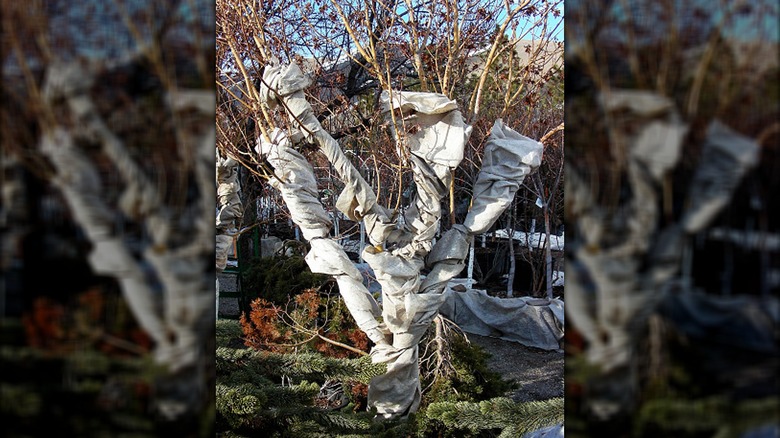Tips For Preventing Moisture Loss On Trees In The Winter
You've taken the time to ensure your yard thrives during the colder months, but have you considered that your trees are also preparing for the harsh winter season ahead? The cold air, dry winds, and frozen ground all work against them, pulling water away from their roots, trunks, and branches. Unlike summer, when trees can easily replace lost moisture, winter makes it so much more difficult.
Deciduous trees drop their leaves in fall, which helps them conserve water naturally — they don't lose moisture through leaves because, well, they don't have any! However, their roots can still dry out, especially if the soil freezes. Evergreens, on the other hand, have their leaves (or needles) all year long, meaning they're constantly losing water through evaporation. That's why you might see brown, crispy patches on pines, cedars, or junipers — this is called winter burn, and it typically happens when the weather is icy enough that the roots don't have access to enough water.
And if you've got palm or fruit trees, they need special attention, too. Palm trees, especially in colder climates, hate freezing temperatures — a cold snap can damage their roots, making it even harder for them to take up water. Fruit trees are a mixed bag — some are more cold-hardy than others, but if their roots dry out too much, you'll see weaker blossoms and a lower fruit yield come spring.
But there is good news! There are simple, effective ways to help your trees hold onto moisture through winter. We're going to cover a few of the best: insulating your trees with mulch, deeply watering them, sheltering their trunks, and using anti-desiccant sprays.
Preventing moisture loss at soil and root level
So much goes on beneath the surface, especially in the case of trees. Think of your roots like a hydration system — if they're dry and exposed in winter, the whole plant suffers. However, you can keep them insulated and hydrated with a few simple steps. Start by placing a 2- to 4-inch layer of preferably organic mulch around the tree to help lock in moisture and regulate soil temperature. Be sure not to pile mulch directly against the trunk — leave a gap of around 3 inches. Try to do this before the first deep freeze, ideally in late fall, to maximize its insulating effects.
You should also deeply water your trees before the ground freezes and when the ground thaws and is able to receive hydration. If the soil goes into winter dry, your tree starts the season at a disadvantage. Use a slow trickle method (yet another reason not to rely on your sprinkler system to water your trees) so the water reaches deeper roots.
It's important to check the soil's moisture throughout winter. An easy way to do this is to grab a screwdriver or soil probe and push it into the ground. If it slides in easily, the soil still has moisture. If it's tough to push in, it's time to give your tree a winter watering session. By keeping your eye on the ground, you're giving your trees a good chance at surviving the cooler months.
Sheltering the tree trunk and branches from the winter cold
Roots aren't the only part of the tree at risk in winter — above-ground damage is a real problem, too. After all, cold winds and dry air pull moisture right out of bark, branches, and leaves. The first step is to take care of your young or thin-barked species (think maples or fruit trees) by wrapping their trunks with a breathable material like burlap or paper wrap to prevent sunscald. It's an easy and affordable way to protect young trees from frost damage and nibbling deer. Just don't forget to remove the protection in early spring so that moisture doesn't build up beneath the coverings. You can also prune your tree of dead, weak, or rubbing branches to prevent snow or ice damage.
If you're feeling sorry for your evergreens, don't. By using an anti-desiccant spray on a completely dormant plant, you can seal the moisture in the leaves or needles so they don't dry out in the cold. These products are lifesavers for broadleaf evergreens like hollies, rhododendrons, and boxwoods. Just make sure to apply them when temperatures are above 40 degrees Fahrenheit. When you take care of your trees above and below ground, you'll help them conserve moisture, prevent winter damage, and set them up for a strong start in spring.


